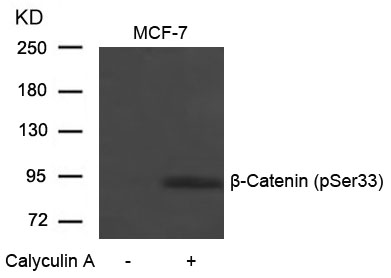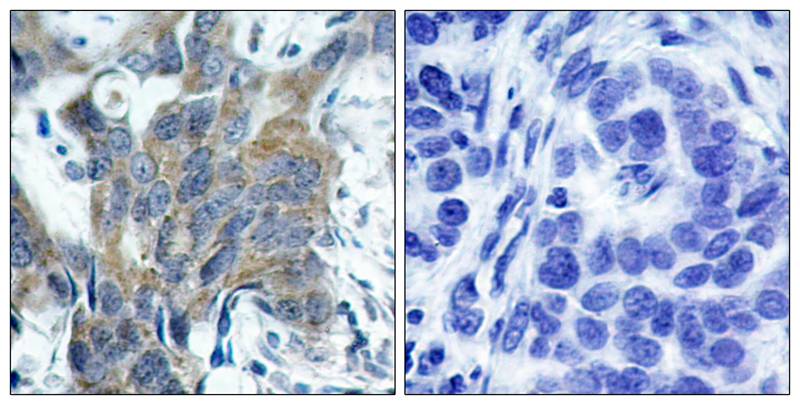

| WB | 咨询技术 | Human,Mouse,Rat |
| IF | 咨询技术 | Human,Mouse,Rat |
| IHC | 1/50-1/100 | Human,Mouse,Rat |
| ICC | 技术咨询 | Human,Mouse,Rat |
| FCM | 咨询技术 | Human,Mouse,Rat |
| Elisa | 咨询技术 | Human,Mouse,Rat |
| Aliases | CTNNB1; CATNB; CTNB1; CTNNB; |
| Entrez GeneID | 1499; |
| WB Predicted band size | 92kDa |
| Host/Isotype | Rabbit IgG |
| Antibody Type | Primary antibody |
| Storage | Store at 4°C short term. Aliquot and store at -20°C long term. Avoid freeze/thaw cycles. |
| Species Reactivity | Human,Mouse,Rat |
| Immunogen | Peptide sequence around phosphorylation site of serine 33 (L-D-S(p)-G-I) derived from Human b-Catenin. |
| Formulation | Purified antibody in PBS with 0.05% sodium azide. |
+ +
以下是3-4篇关于β-Catenin(Phospho-Ser33)抗体的参考文献及其摘要概括:
---
1. **文献名称**: *"Constitutive Transcriptional Activation by a β-Catenin-Tcf Complex in APC⁻/⁻ Colon Carcinoma"*
**作者**: Korinek, V. et al.
**摘要**: 该研究揭示了APC基因缺失导致β-catenin在Ser33等位点的异常磷酸化被抑制,从而使其逃避泛素化降解。研究利用Phospho-Ser33抗体证实了突变型β-catenin的稳定性增加,促进Wnt信号通路的异常激活和结肠癌发生。
2. **文献名称**: *"Casein Kinase I Phosphorylates and Destabilizes the β-Catenin Degradation Complex"*
**作者**: Liu, C. et al.
**摘要**: 文章通过Phospho-Ser33特异性抗体检测到β-catenin在Ser33位点的磷酸化水平受GSK3β和CK1激酶级联调控,并证明该修饰是β-catenin被蛋白酶体降解的关键步骤,为癌症中Wnt信号失调提供了机制解释。
3. **文献名称**: *"Axin-mediated CKI Phosphorylation of β-Catenin at Ser 33: A Molecular Switch for the Wnt Pathway"*
**作者**: Amit, S. et al.
**摘要**: 该研究通过结构分析和Phospho-Ser33抗体验证,发现β-catenin的Ser33磷酸化是Axin复合物介导的降解信号核心事件,揭示了该位点磷酸化如何破坏β-catenin与E-cadherin的结合,促进其核转位。
4. **文献名称**: *"The Axis-inducing Activity, Stability, and Subcellular Localization of β-Catenin Are Regulated by GSK3β"*
**作者**: Yost, C. et al.
**摘要**: 研究利用Phospho-Ser33抗体证明,GSK3β对β-catenin的Ser33磷酸化是其被β-TrCP识别并泛素化的前提条件,调控胚胎发育中Wnt信号的空间分布和强度。
---
这些文献涵盖了β-Catenin(Phospho-Ser33)在信号传导、癌症和发育中的关键作用,并验证了该抗体的应用场景。
β-catenin (Phospho-Ser33) antibody is a specialized tool used to detect β-catenin protein phosphorylated at serine residue 33. a critical post-translational modification regulating its stability and function. β-catenin plays dual roles: as a structural component of cell-cell adhesion complexes and as a key transcriptional co-activator in the Wnt signaling pathway. In unstimulated cells, cytosolic β-catenin is targeted for proteasomal degradation via a destruction complex (Axin, APC, GSK-3β, CK1). Phosphorylation at Ser33 (along with Ser37. Thr41. and Ser45 by GSK-3β) marks β-catenin for ubiquitination by β-TrCP, ensuring low cytoplasmic levels.
This phosphorylation-specific antibody helps researchers investigate Wnt pathway dysregulation, particularly in cancers where mutations or Wnt hyperactivation stabilize β-catenin, enabling nuclear translocation and oncogene transcription. It is widely used in techniques like Western blotting, immunohistochemistry, and immunofluorescence to assess β-catenin phosphorylation status, providing insights into pathway activity, drug responses, or disease mechanisms. Its specificity makes it valuable for distinguishing phosphorylated β-catenin from total protein, aiding studies on cellular signaling dynamics, protein turnover, and therapeutic targeting of Wnt-driven pathologies.
×